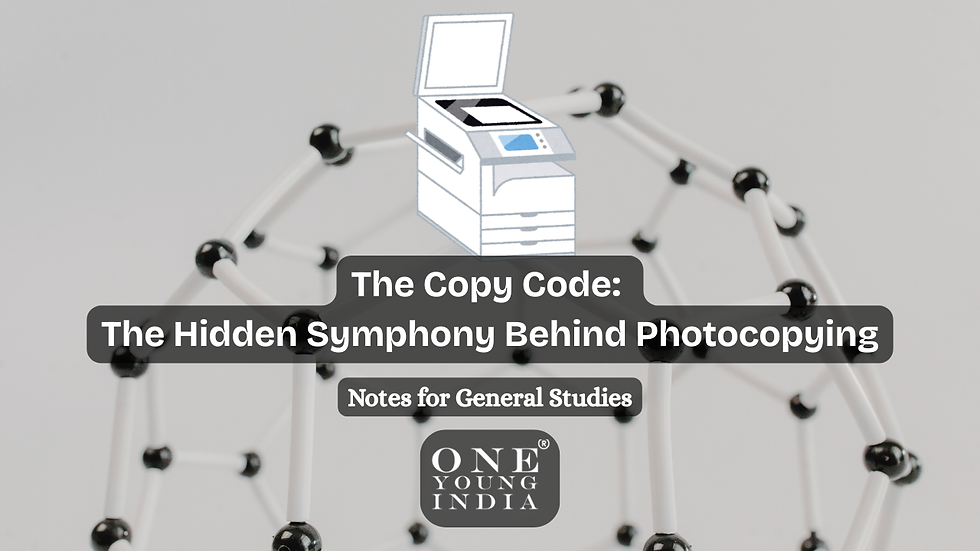The Copy Code: Science, Engineering, and the Hidden Symphony Behind Photocopying
- One Young India

- Oct 17
- 7 min read
I. Introduction
Imagine a student in a bustling college library on the eve of exams. Their notes are incomplete, the printer queue is endless, and the one thing standing between chaos and calm is the familiar hum of a photocopying machine. They place a textbook on the glass, press the green button, and within seconds — an exact replica slides out. Simple, almost magical.

But what really happens in those few seconds?What invisible processes of light, charge, and heat work together to recreate information with such accuracy?
This project explores the science behind photocopying, the intricate dance of physics, chemistry, and engineering that makes it possible, and the innovations shaping its evolution. By unpacking its inner mechanics, we’ll see how one of the most common technologies of everyday life is also a triumph of 20th-century scientific ingenuity.
At its core, photocopying represents the art of control — over light, electrons, and materials — transforming something as intangible as a reflection into a tangible copy. And like all great inventions, it sits at the intersection of necessity, creativity, and precision.
II. Origins: From Inspiration to Innovation
The story begins in 1938, in a small New York apartment, where physicist and patent attorney Chester Carlson struggled with hand-copying documents. His frustration sparked an idea: what if light and static electricity could be combined to reproduce images?
After years of experimentation with sulfur-coated plates and electrostatic charge, Carlson successfully produced the first dry copy — a feat that laid the foundation for what we now call xerography (from Greek: xeros = dry, graphos = writing).
By the 1950s, the technology evolved from laboratory curiosity to industrial marvel when the Haloid Company (later renamed Xerox) commercialized it. The first automatic copier — the Xerox 914 — debuted in 1959 and transformed offices worldwide.
Key Historical Milestones
Year | Development | Significance |
1938 | Chester Carlson creates first xerographic image | Birth of photocopying concept |
1947 | Haloid licenses Carlson’s patent | Beginning of Xerox revolution |
1959 | Launch of Xerox 914 | First commercial automatic copier |
1980s–2000s | Digital transition | Integration of scanning, printing, and copying |
2010s–present | Eco-printing and AI optimization | Rise of energy-efficient and smart copiers |
Each phase of photocopying’s evolution reflects broader industrial trends — from mechanical to digital, from manual operation to automation, from chemical to clean energy.
III. The Science Beneath the Surface
Behind every crisp photocopy lies a perfectly synchronized interaction of three scientific forces:
Optics (Light) – to read the original document
Electrostatics (Charge) – to form and attract the image
Thermodynamics (Heat) – to fuse the image onto paper
Together, these convert information encoded in reflected light into a fixed image made of melted polymer and pigment.
Let’s dissect these layers step by step.
IV. Anatomy of a Photocopier
Every photocopier — no matter how advanced — follows the same basic structure. Think of it as a mini factory of light and charge.
Main Components and Their Roles
Component | Function | Science Involved |
Photoreceptor Drum | Rotating cylinder coated with photoconductive material (often organic compounds or selenium). It holds the latent image. | Photoconductivity |
Corona Wire / Charging Roller | Gives the drum a uniform electrostatic charge. | Electrostatics |
Optical System (Lamp, Lenses, Mirrors) | Projects reflected light from the document onto the drum surface. | Optics |
Toner Cartridge | Contains fine powder (toner) made of plastic resin and pigment. | Chemistry |
Developer Unit | Transfers toner particles to the charged areas of the drum. | Charge attraction |
Transfer Corona | Charges the paper so toner moves from drum to paper. | Electrostatic induction |
Fuser Assembly | Uses heat and pressure to permanently fuse toner onto the paper fibers. | Thermodynamics |
Cleaning Blade | Removes residual toner from the drum. | Mechanical process |
V. The Process: Step-by-Step Reproduction
Every copy follows a tightly sequenced chain of events — a six-step scientific choreography.
Step 1: Charging
The photoconductive drum spins while being uniformly charged by the corona wire (a thin wire that emits ions).
The entire surface now carries a positive static charge.
This charge will later be selectively erased by light.
Step 2: Exposure
A powerful lamp scans the document placed on the glass.
White areas of the page reflect light, while dark text absorbs it.
Light striking the drum neutralizes those charged areas by making them conductive.
The dark areas remain charged, forming an invisible electrostatic “latent image.”
Step 3: Developing
Now enters the toner — tiny particles that carry a negative charge.
The toner is attracted to the positively charged regions on the drum (the dark parts of the image).
The previously invisible image becomes visible as a fine powder pattern.
Step 4: Transfer
A sheet of paper passes close to the drum.
The transfer corona gives it a negative charge, stronger than the drum’s hold on the toner.
The toner particles leap from the drum to the paper’s surface.
Step 5: Fusing
The paper moves through heated rollers (around 180°C).
Heat melts the toner’s plastic resin.
Pressure embeds the molten toner into the paper fibers.
The image becomes permanent, smudge-proof, and water-resistant.
Step 6: Cleaning and Resetting
A cleaning blade scrapes any residual toner off the drum.A discharge lamp neutralizes remaining static charge — preparing the system for the next cycle.
VI. The Physics in Action
1. Light and Reflection
The copier’s optical subsystem acts like a scanner-camera hybrid. Light rays reflect off bright surfaces and are absorbed by dark ink. Lenses and mirrors redirect this reflection onto the rotating drum.
Equation of light reflection:
Angle of Incidence=Angle of ReflectionAngle of Incidence=Angle of Reflection
This precise control ensures every dot of contrast on the original is faithfully mapped.
2. Electrostatics
The engine of photocopying lies in Coulomb’s Law:
Opposite charges attract; similar charges repel.Every toner particle moves according to these forces — guided not by logic circuits but by nature’s own electric fields.
3. Photoconductivity
The drum coating’s ability to change conductivity under light is the heart of xerography.
In darkness: it’s an insulator, retaining charge.
Under illumination: it conducts, allowing charge to dissipate.This controlled switching encodes the image pattern.
VII. The Chemistry of Toner and Paper
Composition of Toner
Ingredient | Function |
Thermoplastic polymer (e.g., styrene-acrylate) | Melts and fuses to paper |
Carbon black / Pigment | Provides color |
Charge-control agents | Maintain consistent polarity |
Silica additives | Improve flow and prevent clumping |
When heated, the toner’s polymer melts around 150–200°C.The molten material embeds itself into paper fibers through pressure, ensuring permanence.
VIII. From Analog to Digital: The Evolution of Copying
The first generation of photocopiers were purely optical-mechanical: lenses, lamps, and mirrors performed every task.But the digital age revolutionized the process.
Digital Workflow:
The document is scanned into an image file.
A laser beam projects the digital pattern onto the drum.
The rest of the process (toner, transfer, fusing) remains similar.
This shift improved:
Resolution and consistency
Speed (pages per minute)
Integration with computers and cloud systems
Color accuracy through CMYK layering
Today’s copiers are multifunctional: scan-print-copy-fax, all in one.They are essentially networked imaging computers disguised as office machines.
IX. Data & Scale: Global Copying Footprint
Even in the digital era, photocopying remains colossal in scale.
Metric | Estimate (2024–25) | Source |
Global photocopier units in use | ~35 million | Statista |
Annual pages copied | Over 2.4 trillion | IDC Research |
Average copier power use | 1.5–2.0 kWh per 1,000 pages | Energy Star |
Average toner recycled | ~68% of cartridges worldwide | World Toner Council |
India alone accounts for an estimated 8–10 billion pages annually, primarily in education, administration, and small enterprises. The affordability of copies (₹1–₹2 per page) keeps it indispensable despite digitization drives.
X. The Environmental Equation
Photocopying consumes paper, toner, and electricity — resources that directly impact sustainability.
Key Challenges
Paper waste: A single tree yields roughly 8,000 A4 pages.
Toner emissions: Contains microplastics and volatile compounds.
Energy footprint: Continuous standby power draws cause hidden consumption.
Greener Solutions Emerging
Duplex printing (both sides): cuts paper use by 40–50%.
Recycled paper and bio-toners reduce environmental load.
Sleep-mode energy management cuts idle electricity draw.
Digital archiving replaces physical copying when possible.
The next wave of innovation focuses on low-melt toners, carbon-neutral manufacturing, and AI-driven paper optimization — turning the copier from a resource consumer into an eco-efficient ally.
XI. The Societal Impact: Access and Information Equity
For many regions, especially in developing economies like India, photocopying is not merely a convenience — it’s a democratizer of knowledge.
Students access study materials affordably.
Small businesses reproduce forms, bills, and legal documents.
Government offices ensure record duplication in low-digital zones.
The humble copy shop is often the gateway to participation in education and administration — bridging the digital divide.
Thus, photocopying embodies an understated form of information equity — ensuring access where infrastructure is limited.
XII. The Future: From Light to Code
The photocopying industry is quietly reinventing itself for the AI and data era.
Emerging Trends
AI-enhanced scanning – automatic error correction and contrast optimization.
Blockchain document verification – ensuring authenticity of copies.
Nanographic inks – energy-efficient, recyclable alternatives to toner.
Self-cleaning drums and low-friction fusers – extending lifespan by 40–50%.
Integrated cloud ecosystems – copies saved directly to Google Drive or institutional archives.
The future copier may no longer “copy” in the traditional sense — it will capture, process, secure, and share.What began as a machine of replication is evolving into a node of digital intelligence.
XIII. Conclusion: A Symphony of Science
From the outside, a photocopier is just another office machine. But inside, it’s a symphony — light dancing across mirrors, charges forming invisible patterns, and heat sculpting permanence out of powder.
The act of copying is, in essence, a fusion of physics and purpose. It shows how static electricity, once a curiosity that made balloons stick to walls, can be harnessed to replicate knowledge billions of times over.
For students and engineers, the photocopier is more than a machine — it’s a lesson in applied science:
Physics teaches how light and charge interact.
Chemistry explains how polymers melt and bind.
Engineering demonstrates how precision design synchronizes it all.
In an age where data moves at the speed of light, photocopying remains a silent but enduring reminder — that even the most ordinary technologies are built on extraordinary science.



